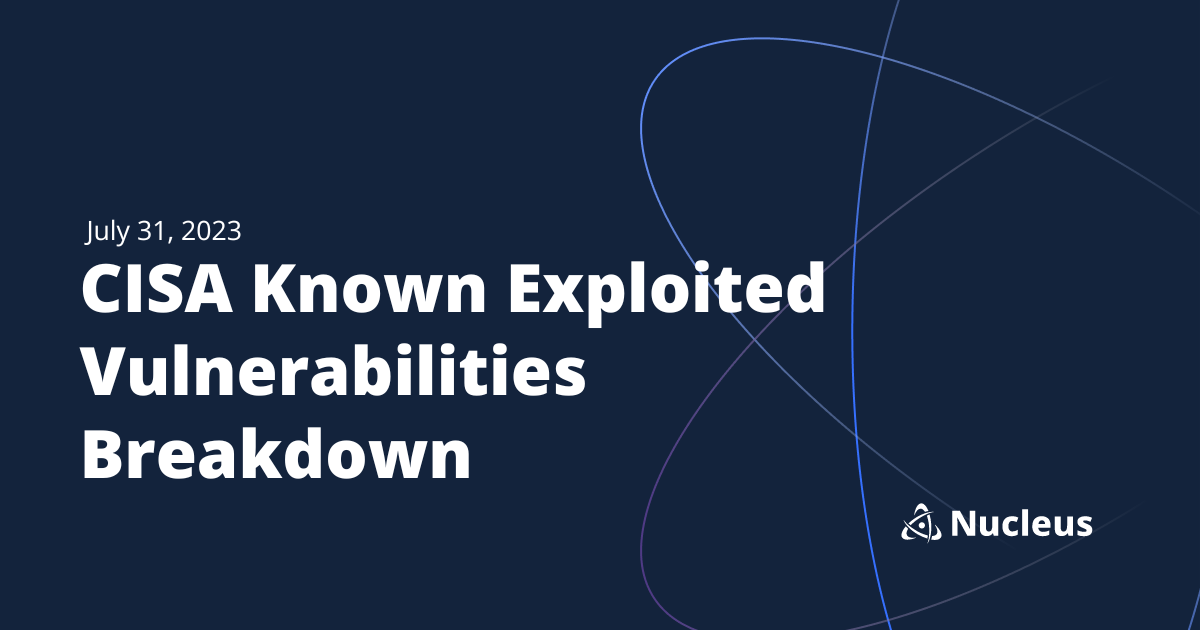July 31, 2023 CISA KEV Breakdown | Ivanti

July 31: 1 New Vuln | CVE-2023-35081
In this CISA KEV Breakdown, one vulnerability in Ivanti’s EPMM that appears to be the other link in the exploit-chain alongside CVE-2023-35078 was added after disclosure with the vendor has resulted in a stable patch released late last Friday. We discussed this first link in the chain in our July 25 Breakdown post.
[wptb id=22373]Notable Vulnerability Additions
CVE-2023-35081 | Ivanti Endpoint Manager Mobile Remote Code Execution
A vulnerability was disclosed in Ivanti’s EPMM affecting releases 11.10, 11.9 and 11.8 that can allow an attacker to place written files to a vulnerable device. An attacker would first need to escalate privileges in order for this vulnerability to be exploitable, which is, according to the Ivanti disclosure, what attackers used in exploitation against known victims of CVE-2023-35078. With the use of CVE-2023-35078 as a means to bypass the authentication required to access sensitive API endpoints paired with the writing of files with CVE-2023-35081, it is possible for an attacker to install webshells or other malicious code on devices hosting the vulnerable EPMM.
This vulnerability was discovered by and disclosed to Ivanti by security vendor Mnemonic who released threat advisories for both CVE-2023-35078 as well as CVE-2023-35081. Mnemonic suggests they have observed exploitation of this vulnerability in which malicious JSP and Java .class files were written to disk. Organizations who want to assess the possibility they have been breached as well as protect against future attacks can do the following:
- Look for API calls in logging where the endpoint path was prepended to the base path for the API. For example, an attacker bypasses authentication through CVE-2023-35078 by prepending a sensitive endpoint path
/sensitive-endpointto the base path:{managenent_console_address}/sensitive-endpoint/api/v2rather than the typical call which would look like{management_console_address}/api/v2/sensitive-endpoint. - Update Ivanti EPMM to the latest stable release that also fixes CVE-2023-35081: 11.8.1.2, 11.9.1.2 and 11.10.0.3.
Security Advisory(s):
https://forums.ivanti.com/s/article/CVE-2023-35081-Arbitrary-File-Write?language=en_US
← July 26, 2023 CISA Kev Breakdown
Click here to expand our CISA KEV Breakdown Frequently Asked Questions
- What makes for a notable addition?
- A notable addition can arise from many different characteristics. If a particular vulnerability is notable to the security community or a subset of the security community or if the EPSS score reveals notable information about the vulnerability, this can constitute further analysis. It may also be the case that a particular vulnerability shines a light on everyday users and we will highlight important information and key takeaways to ensure users and readers have easy access to actionable information.
- When is the Breakdown released?
- We aim to have our analysis of each KEV update posted within 24 hours of the time in which the Catalog is updated. See CISA’s full catalog here
- I am not bound by BOD 22-01 or federal regulations, why should the KEV concern me?
- CISA encourages all organizations to utilize the Catalog as an attribute in your vulnerability prioritization framework. Organizations looking to lessen the scope on known dangerous vulnerabilities and make a goal to remediate them can understand where they currently stand against what CISA has confirmed as exploited vulnerabilities in the wild. See CISA’s section on “How should organizations use the KEV catalog?” here.
- What is EPSS?
- EPSS is the Exploit Prediction Scoring System. It is an open, data-driven effort for estimating the likelihood (probability) that a software vulnerability will be exploited in the wild. See the EPSS home page on FIRST for more information here.
- What is the difference between EPSS probability and EPSS percent?
- EPSS probability is the risk calculated by the model when determining the perceived threat of the vulnerability itself. Percentage is a relative comparison of the rest of the CVEs within the given sample. While the probability only changes upon refreshing the results from the model, the percentage can change purely based on the CVE sample given. In the case of the Breakdown, we use the percentage given by the pool of all CVEs with given EPSS data. Scores may vary post-release of the post given new information about the vulnerabilities and their perceived threat. For more information on applying and understanding EPSS data, see this article on the FIRST website, as well as their FAQ page.
- What is GreyNoise?
- GreyNoise is a platform that collects, analyzes, and labels data on IPs that scan the internet and saturate security tools with noise. Through their sensor network, GreyNoise observes vulnerability exploitation attempts for vulnerabilities that are exploited in the wild over the Internet. These are arguably vulnerabilities that should be at the very top of your priority list to remediate.
- Why are GreyNoise exploitation attempts only observed on ~20% of KEV vulnerabilities?
- Exploitation of many vulnerabilities in the CISA KEV will not be observed for many reasons that GreyNoise does a good job of explaining in this post. For example:
- The vulnerability may not be remotely exploitable
- Vulnerability exploitation may require authentication (and result in privilege escalation)
- The impacted software may not be exposed to the internet
- Mass scanning/exploitation is not occurring yet
- Exploitation of many vulnerabilities in the CISA KEV will not be observed for many reasons that GreyNoise does a good job of explaining in this post. For example:
See Nucleus in Action
Discover how unified, risk-based automation can transform your vulnerability management.






























